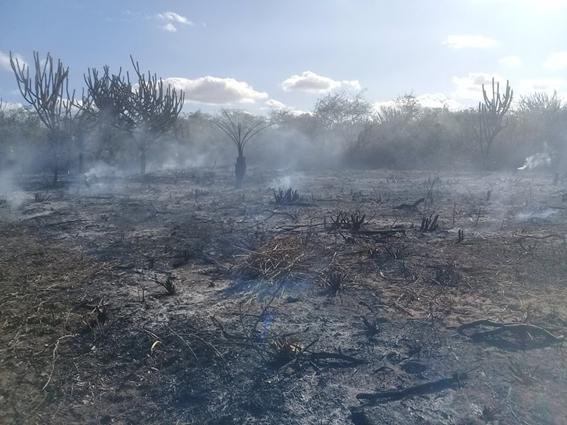Jakelyne Suelen Bezerra de Sousa
This project has as main objectives to understand the relative effect of slash-and-burn agriculture on forest regeneration, separately evaluating the seed bank, seed rain and resprouting. In particular, understanding how slash-and-burn agriculture affects forest regeneration (i.e., resilience) and the persistence of secondary forest stands is critical to biodiversity conservation. This knowledge is also necessary to improve the delivery of important ecosystem services, such as above-ground biomass and soil fertility; essential services to guarantee the sustainability of slash-and-burn agriculture and the well-being of local populations. The productivity of the ecosystem and agriculture depends on forest regeneration, so it is essential to understand the drivers of this process.

Land preparation for slash-and-burn agriculture at Catimau National Park (Pernambuco northest Brazil). © Rafaela Lins
The delivery and sustainability of forest services depend on the forest's ability to regenerate after human-induced disturbances. Although there has been significant research effort to understand forest regeneration in the tropics, the mechanisms promoting forest recovery in tropical dry forests remain poorly understood. Despite supporting almost one billion people worldwide, poor management of dry forests has caused loss of biodiversity, resilience of the depressed ecosystem and limited supply of forest services for the subsistence of human populations. Slash-and-burn agriculture is a common practice in dry forests, such as the Caatinga, but no study to date has evaluated the impact of this practice on forest regeneration. Using an experimental approach, our goal is to understand how slash-and-burn agriculture affects different forest regeneration mechanisms and, consequently, forest resilience and the ability of secondary forests to retain biodiversity and provide ecosystem services.

Land preparation for slash-and-burn agriculture at Catimau National Park (Pernambuco northest Brazil). © Rafaela Lins
Our project will be carried out in the Catimbau National Park, which covers 607 km2 in the state of Pernambuco, Brazil. The Park was created in 2002 and has a large area of archaeological importance, with a significant role in the conservation of the natural history of the human population and one of the few still preserved in Brazil. However, since its creation, residents have never been compensated by the government and continue to live inside the park. Local communities continue to exert strong pressure on fauna and flora, which creates a scenario of intrinsic dependence on human populations and natural resources. Slash-and-burn agriculture has been an important source of subsistence for at least three centuries, with the cultivation of beans, corn and other vegetables widespread in the region.
This project aims to quantify the impacts of slash-and-burn agriculture on the seed bank, seed rain and resprouting. Our hypothesis is that this agricultural practice is one of the main causes of forest degradation and desertification, mainly through the alteration of important sources of forest regeneration, such as the resprouting and the seed bank. Our findings will have important implications for improving agricultural practices, making them more favorable to biodiversity. Among other knowledge, we will propose a comprehensive list of best agricultural practices to improve forest regeneration or resilience in the context of slash-and-burn agriculture. These practices are expected to cover aspects related to deforestation, agricultural production and management of secondary forest stands. This guide will be available to all interested parties on the Long-Term Ecological Project (LTEP-Catimbau) homepage (www.peldcatimbau.org).